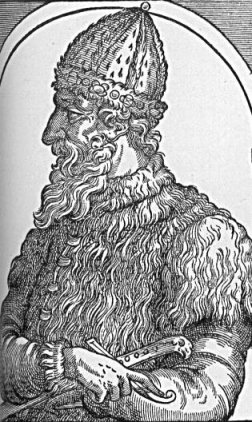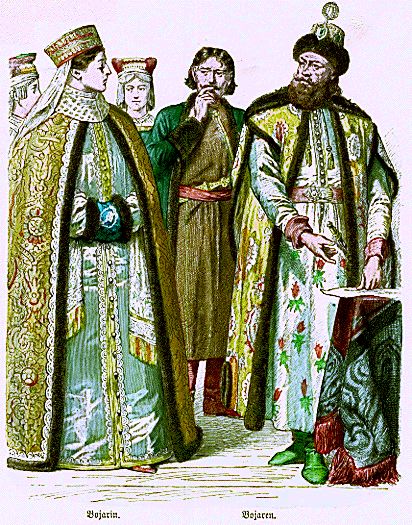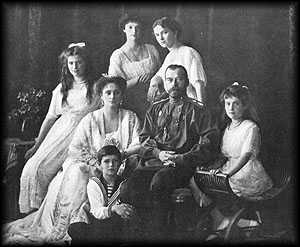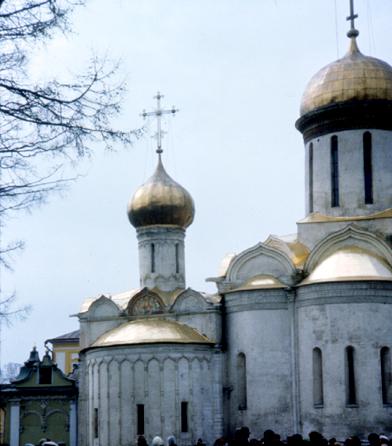Czarist Russia 1462-1703
 Russia's
modern period begins in 1462 with the growth of the Muscovy state and the power
and influence of Ivan III and his descendants. The capital of Russia
became Moscow, and it was during this era that Russia developed many of the
characteristics that lasted into the twentieth century. The concept of
czardom evolved, and the centralization of government under a despot was
established. The church was subordinated to the state; the peasant was
tied to the land; the middle class lost all its power and influence and became a
tool of the government; and the Imperialistic expansion of Russia began.
Russia's
modern period begins in 1462 with the growth of the Muscovy state and the power
and influence of Ivan III and his descendants. The capital of Russia
became Moscow, and it was during this era that Russia developed many of the
characteristics that lasted into the twentieth century. The concept of
czardom evolved, and the centralization of government under a despot was
established. The church was subordinated to the state; the peasant was
tied to the land; the middle class lost all its power and influence and became a
tool of the government; and the Imperialistic expansion of Russia began.
The Establishment of the Russian State 1462-1703
Ivan III, Vasily III, and Ivan IV
Ivan III and his son, Vasily III, referred to themselves as
"czar and autocrat by the grace of God of all Russia." In 1547 Ivan IV was
officially proclaimed czar, a word derived from "Caesar" like the German word
"Kaiser." The Russian state was established during the reigns of these
three princes of Moscow. The Tartars were driven from the land; the
separate, independent principalities were gathered in; and government was
centralized under the czar. The era dominated by the princely family had
ended, and the Russian national state was born.
Ivan III and Vasily III ruled Russia in cooperation with the boyarskaya
duma, a council of hereditary landed aristocrats (boyars). Although
this system worked fairly well under Ivan III, the grand prince of Moscow more
and more came into conflict with the ancient aristocracy. It was Ivan IV
who was to make himself supreme autocrat in Russia by destroying the power of
the aristocracy.
1) He struck at the influence of the boyars by dividing Russia into two
parts, half controlled directly by the new body, the Oprichnina, a
council of 1000 men personally responsible to the czar. The Oprichniks'
main task was to destroy those who represented a challenge to Ivan's power,
specifically the boyar class (although all classes were subject to their
terror).
Boyars
2) The landed aristocrats lost their special privileges, such as the
right to transfer allegiance to another prince and their hereditary right to
their lands. The nobles became merely servants of the state, bound to act
as officials for the prince of Moscow, and land ownership was made contingent
upon loyalty and allegiance to the czar. In effect, a new landlord class
was created.
3) Once the boyars were eliminated there was nothing in Russia to
compete with the czar's authority, although the church did offer occasional
resistance.
The Time of Troubles and the Zemsky Sobor
Ivan IV's government was totally dependent upon the personality of the czar,
and when Ivan died in 1584, having killed the son he had named as successor and
leaving his feebleminded son Fedor and the infant Dmitry, he bequethed to Russia
years of anarchy and civil war. Dmitry was killed, and with Fedor's death
in 1598 the line of succession ended and the Russian state collapsed. By
1611 the Poles controlled the southwest including Moscow and the Swedes had the northwest. There was no government, no
leadership, and the land was devastated.
Moscow and the Swedes had the northwest. There was no government, no
leadership, and the land was devastated.
The results of fifteen years of chaos were disastrous. The boyars were
extinct as a class, the peasant had no choice but to sink further and further
into the clutches of the gentry, and the country was on the brink of economic
collapse.
In 1612 the assembly of the land, Zemsky Sobor, representing all classes, met
and elected Michael Romanov czar. Although the assembly of people had
brought the Romanovs to power, the idea of a representative government never
took hold. It was never intended that the assembly should assume permanent
powers, and it never developed into an independently functioning body
because of lack of unity. Consequently, the Zemsky Sobor was not capable
of opposing the will of the supreme autocrat and was called upon only when the
czar wished ratification of a policy. The Romanovs were new rulers, but
they continued the policy of forcing everyone to serve the state.
Romanov Family
The Russian Orthodox Church and its Conflict with the State
The Russian Orthodox church, from the moment of its conception, was linked
with the power of the state. During the sixteenth and seventeenth
centuries it became subordinate to the state, and in the following centuries it
deteriorated into a mere tool of the czar.
The Moscow Patriarchate
The creation of the Moscow patriarchate (archbishopric) was Boris
Godunov's achievement in 1589. It was the patriarch Job who assisted in
Boris' election as czar. The patriarchate, from its creation, was
therefore closely allied with the state.
 Nikon
Nikon
Within the ranks of the clergy there was a desire to reform the Russian
church by drawing it into closer unity with the Eastern (Greek Orthodox) church.
In 1652 Nikon was elected Russian patriarchate and began the revision of the
service books. The church split over the issue: the old believers refused
to accept the reforms. Nikon triumphed with the aid of the state, but in
doing so he forecast the destruction of the independent power of the church and
its subordination to the state.
With ambition similar to that of the great Western ecclesiastics, Nikon
attempted to make the church stronger than the state. He was finally
deposed and exiled. The effect of his efforts was to precipitate the
decline of the power of the church and to identify religious dissent with
movements against the government's authority. No other patriarch in
Russian history ever again challenged the authority of the state in secular
matters.
The Peasant and Serfdom
Once an independent farmer, the peasant became a tenant during the fourteenth
century primarily because he had been driven into debt by Mongol taxation and
felt the need for protection. At first he was free to move, although there
were agreements among landowners not to accept him. By the middle of the
fifteenth century the peasant could leave the land only during a two-week period
in November. Vasily II, however, forbade the peasants on certain estates
to move at all.
Although serfdom did not become official until 1645, the peasant was in
bondage much earlier. As a tenant, he soon fell further into debt, since
he was paying exorbitant rates of interest. Those who were not in
financial bondage to a lord were nevertheless subject to fines for leaving the
land and were forced to pay annual rent amounting to one-quarter of the value of
there homestead, which meant that they could not afford to leave their land
either.
In 1645, under Alexis, a new legal code divided the people into rigid
classes. Townspeople were bound to the towns, the church and the nobility
were declared closed classes, and most peasants were bound to the land by law.
Thus the condition of serfdom that had existed for so long was made official.
The landlord exercised judicial, fiscal, social, and legal authority over his
serfs, but the peasant did not accept his fate submissively. Russian
history from this period on is characterized by peasant uprisings. In 1650
a rebellion raged in Pokov; during the plague of 1655 constant revolts occured
in the central regions of Russia; in 1662 there was a revolution in Moscow and
7000 were executed. In 1670 one of the most famous rebellions of all took
place: this uprising, led by Stenka Razin was symptomatic of peasant
dissatisfaction and acarchy.
The Imperialistic Expansion of Russia
Ivan III, Vasily III, and Ivan IV
The extent of Moscow-controlled lands was trebled during the reign of Ivan
the Great (1462-1505). This was accomplished by both war and diplomacy.
By 1489 the northeast was under Muscovy domination, but the campaigns in the
west were less successful. Ivan III was not militarily strong enough to
challenge Poland-Lithuania.
Control of the prosperous city of Novgorod and its lands was one of Ivan's
objectives. Under his son the veche bell, symbol of Novgorod's
imdependence, was removed to Moscow, and leading families were exiled.
Ivan defeated the last remnants of the Golden Horde by 1556. The
conquest of Kazan opened up for colonization the fertile land of the middle
Volga. Western Siberia was claimed in 1584, but in the west Ivan lost a
twenty-year war against Sweden and Poland.
The Time of Troubles and the Romanovs
During the time of troubles (1605-1613) Russia lost much newly acquired land,
and during the reign of the first Romanov remained militarily weak and on the
defensive. It did expand eastward across Siberia, however, and southward
into the Amur basin, ultimately leading to conflicts with China.
It was not until Alexis' rule (1645-1676) that Russia again went on the
offensive. It moved against Poland's control of the Dnieper in 1649, and
in 1667 the Ukraine was split. The right bank of the Dnieper was to remain
Polish and Moscow gained the left bank and Kiev. Russia had not controlled this
part of the Ukraine since the Mongol invasions of the 13th century
 Russia's
modern period begins in 1462 with the growth of the Muscovy state and the power
and influence of Ivan III and his descendants. The capital of Russia
became Moscow, and it was during this era that Russia developed many of the
characteristics that lasted into the twentieth century. The concept of
czardom evolved, and the centralization of government under a despot was
established. The church was subordinated to the state; the peasant was
tied to the land; the middle class lost all its power and influence and became a
tool of the government; and the Imperialistic expansion of Russia began.
Russia's
modern period begins in 1462 with the growth of the Muscovy state and the power
and influence of Ivan III and his descendants. The capital of Russia
became Moscow, and it was during this era that Russia developed many of the
characteristics that lasted into the twentieth century. The concept of
czardom evolved, and the centralization of government under a despot was
established. The church was subordinated to the state; the peasant was
tied to the land; the middle class lost all its power and influence and became a
tool of the government; and the Imperialistic expansion of Russia began.

 Moscow and the Swedes had the northwest. There was no government, no
leadership, and the land was devastated.
Moscow and the Swedes had the northwest. There was no government, no
leadership, and the land was devastated. Nikon
Nikon